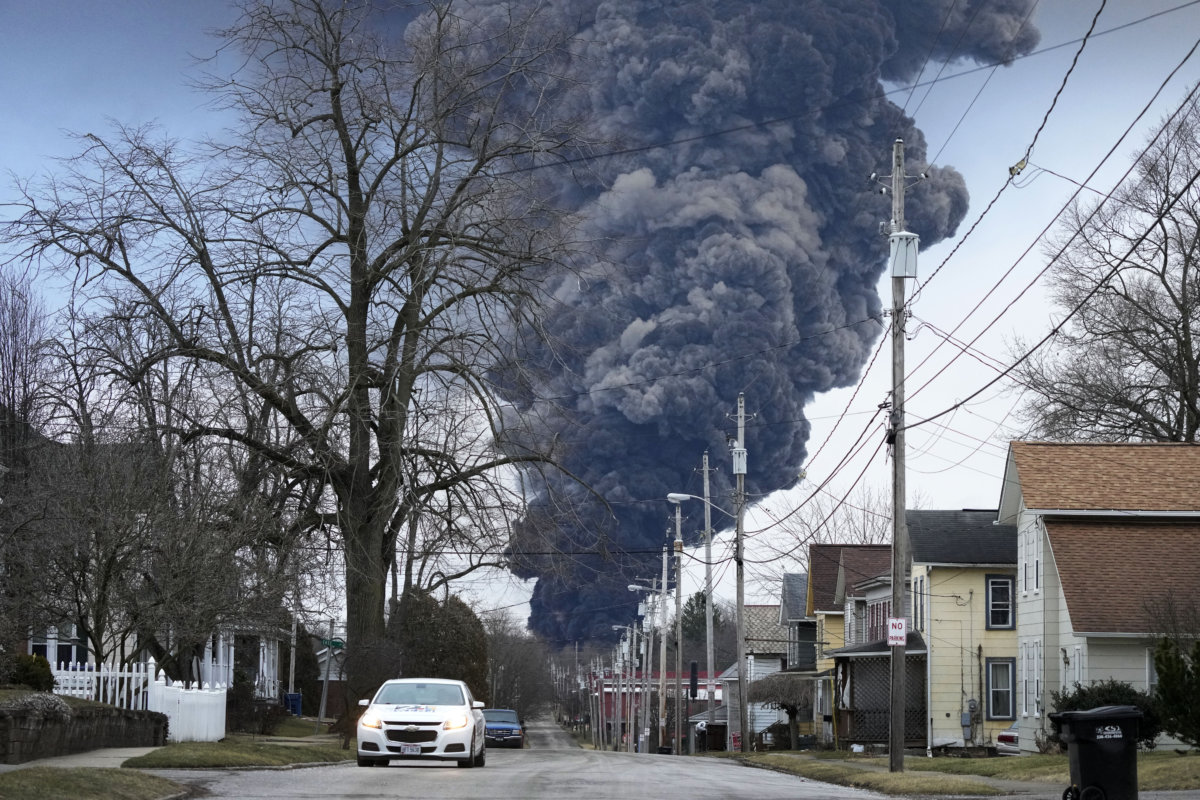Plumes of smoke, questions about dead animals, worries about the drinking water. A train derailment in Ohio and subsequent burning of some of the hazardous chemicals has people asking: how worried should they be?
It’s been more than a week since about 50 cars of a freight train derailed in a fiery, mangled mess on the outskirts of East Palestine near the Pennsylvania state line, apparently because of a mechanical issue with a rail car axle. No one was injured in that wreck. But concerns about air quality and the hazardous chemicals on board the train prompted some village residents to leave, and officials later ordered the evacuation of the immediate area as fears grew about a potential explosion of smoldering wreckage.
Officials seeking to avoid the danger of an uncontrolled blast chose to intentionally release and burn toxic vinyl chloride from five rail cars, sending flames and black smoke again billowing high into the sky. The jarring scene left people questioning the potential health impacts for residents in the area and beyond, even as authorities maintained they were doing their best to protect people.
In the days since, residents’ concerns and questions have only abounded — amplified, in part, by misinformation spreading online.
More on what we know:
WAS THE CONTROLLED BURN SAFE?
Vinyl chloride is associated with increased risk of certain cancers, and officials at the time warned burning it would release two concerning gases — hydrogen chloride and phosgene, which was used as a weapon in World War I. Environmental officials say that monitors detected toxins in the air at the site during the controlled burn and that officials kept people away until that dissipated. They say continuing air monitoring done for the railroad and by government agencies hasn’t detected dangerous levels in the area — including during testing inside nearly 400 homes — since residents were allowed to return. The U.S. Environmental Protection Agency has shared air monitoring results online.
WHAT ARE THE CONTINUING CONCERNS?
Even in communities beyond East Palestine, some residents say they worry about long-term effects of even low-grade exposure to contaminants from the site. The village has scheduled a town hall at the local high school Wednesday evening to hear questions from residents, whose concerns have included lingering smells, how to ensure accountability for the cleanup, and what to make of pets and livestock that have appeared ill or died since the derailment.
The risk to such animals is low, according to the Ohio Department of Agriculture, which recommended that people contact a local veterinarian for any concerns about their livestock or pets’ health. The department hasn’t received any official reports about livestock or pet illnesses or deaths directly related to the incident, though making such a determination would require a necropsy and lab work, ODA said.
The derailment also highlighted questions about railroad safety, though federal data show accidents involving hazardous materials at this scale are very rare. Trains were rolling past East Palestine again soon after the evacuation order was lifted.
WHAT ABOUT THE GROUND AND WATER?
Contaminants from derailed cars spilled into some waterways and were toxic to fish, but officials have said drinking water in the area has remained protected.
In addition to vinyl chloride, at least three other substances — butyl acrylate, ethylhexyl acrylate, and ethylene glycol monobutyl — were released into the air, soil or water, according to a U.S. Environmental Protection Agency letter putting rail operator Norfolk Southern on notice about its potential liability for cleanup costs.
Norfolk Southern’s response has included efforts to remove spilled contaminants from the ground surface and nearby streams, as well as air quality monitoring, soil sampling and residential water well surveys, according to its preliminary remediation plan.
The Ohio Department of Natural Resources estimates the spill affected more than 7 miles of streams and killed some 3,500 fish, mostly small ones such as minnows and darters.
In response to reports that butyl acrylate was detected in the nearby Ohio River, some water companies that draw drinking water from it — even hundreds of miles from the site — say they’re monitoring water quality or increasing treatment processes as a precaution and could temporarily shut off those intakes if necessary.
ARE SOCIAL MEDIA CLAIMS ABOUT THIS SITUATION ACCURATE?
As with any developing situation, misinformation and hyperbole have spread online about the derailment in recent days.
Social media users, for example, falsely claimed that drinking water is contaminated throughout the entire Ohio River basin when many areas in the multistate region are not affected by the chemical release.
Footage of dark, ominous clouds has also spread with claims it showed East Palestine post-burn, despite the fact that the footage appeared online as early as November 2022.
As information continues to develop, disinformation experts emphasize that people should exercise caution before sharing unverified claims.
WHAT MAY HAVE CAUSED THE ACCIDENT?
Investigators examined the rail car that initiated the derailment and have surveillance video from a home showing “what appears to be a wheel bearing in the final stage of overheat failure moments before the derailment,” the National Transportation Safety Board said Tuesday. Its preliminary report is expected in two weeks.
Rail operator Norfolk Southern and the NTSB haven’t publicly answered one of the big questions about the Feb. 3 derailment, however: Exactly when was the crew alerted to a mechanical issue with a rail car axle — the suspected cause — and did they respond appropriately?
A wayside defect detector alerted the crew to a mechanical issue “shortly before the derailment,” and emergency braking was initiated, a National Transportation Safety Board member said that weekend.
Security video from two businesses in Salem, Ohio, shows the underside of one rail car glowing brightly from an apparent fiery axle, indicating the train might have traveled more than 20 miles with that malfunction before the derailment, the Pittsburgh Post-Gazette reported. The NTSB says it’s reviewing that video, too.































